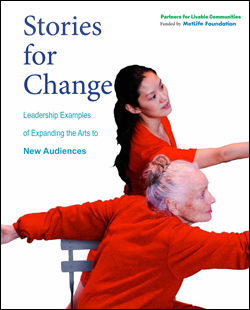Stories for Change
Leadership Examples of Expanding the Arts to New Audiences
116 pages, May 2012. Partners for Livable Communities, 1429 21st Street NW, Washington, D.C. 20036, (202) 887-5990 www.livable.org.
Download:
![]() Stories for Change (2.5Mb)
Stories for Change (2.5Mb)
Arts and cultural organizations support community and economic development by meeting the needs of diverse and sometimes vulnerable populations. The authors of this report assert that cultural strategies are not only a major economic force in many communities but contribute tremendously to education, cultural identity, race relations, community pride, quality of life, and the livable community; and that Arts organizations are receptive, creative, and resourceful, and can apply their talents to turn neighborhood tensions into opportunities for interaction.
This report is a compendium of best practices that builds upon the findings of Culture Connects All: Rethinking Audiences in Times of Demographic Change, the 2010 report by Partners for Livable Communities. Culture Connects All describes the state of the arts and cultural sector in a time when two populations are rapidly expanding: older adults (65 and older) and immigrants, and provides a series of recommendations for arts and cultural organizations to reach out, and adapt their programs in new ways. Culture Connects All explores six cities in-depth along with fully-developed, groundbreaking programs that focus on attracting immigrant and older adult audiences in each of those cities.
This report responds to the request for more stories: additional best practices that showcase the strategies of many unique organizations, not generally in the spotlight, that have designed arts and cultural programs, and some non-arts programs, to serve older adults and immigrants. Stories abound of arts and cultural centers tutoring all age groups in English as a Second Language; sparking imaginations through the visual arts; refining math skills in after-school programs; incorporating Alzheimer’s patients and caregivers in museum programs; or casting parts in theater productions without regard to age. Many of these model programs are unknown beyond their regional boundaries, and are occurring in smaller institutions and communities that are too-often overlooked.
Many of these best practices can be easily implemented, and do not require a major overhaul of staffing, operations, or an organization’s mission. Others call for partnerships with community, regional, state, or national organizations. And some, like the well-known Alzheimer’s Project of the Museum of Modern Art, require staffing, partnerships, and considerable funding; even so, that relatively complex model has been adapted in museums of all sizes across the country. These best practices were carefully chosen to create a varied collection. The criteria for selection included a range of considerations: the types of institutions; innovative practices or programs; the population served; and the geographic location and size of the community where the programs take place. From Partners’ perspective, arts and cultural institutions encompass theater, opera, and dance companies; libraries; botanic gardens; community arts organizations; public parks; orchestras; museums; and organizations for historic preservation. This broad scope is an acknowledgement that many organizations, though not traditionally defined as arts or cultural in nature, nonetheless serve as hubs for creativity and exploration in a community and often demonstrate the characteristics that appeal to new audiences and participants. In a few cases, best practices included in this compendium do not feature arts and culture, or do not serve older adults or immigrants, but showcase strategies or practices that could be adapted for arts and cultural programs.
The authors of this report observe that leaders in the nascent stages of this work are hungry to learn from their peers and the communities currently benefitting from these models, and to hear those stories that are often lost in the national, regional, and even local discussions about how institutions can operate as instigators of change. These stories for change not only describe personal accounts of trial, error, and success, but also impart an understanding of the steps taken to create a model that can be emulated by others.
More information about this report at http://livable.org/livability-resources/reports-a-publications/564-stories-for-change-.

